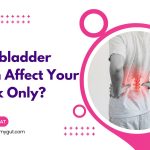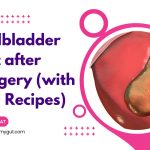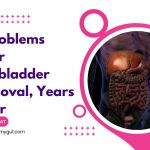Does Massaging Help During a Gallbladder Attack?
Our content is not intended nor recommended as a substitute for medical advice by your doctor. Use for informational purposes only.
What is the mechanism of a gallbladder attack?
Biliary colics occur due to the contraction of the gallbladder (usually after eating) over the gallstone inside it. The contraction causes temporary obstruction of the gallbladder with subsequent biliary colic.
The temporary obstruction of the gallbladder often resolves a few hours later, causing no complications (only the pain).
The detailed symptoms of biliary colic due to uncomplicated gallstone diseases are in the table below:
| Biliary colic (Uncomplicated gallstone). | Description |
| 1. Site | Usually, The right upper quadrant of your abdomen. |
| 2. Spread | – The pain may spread to the back of the right shoulder.– Also, it spreads to the epigastric area. |
| 3. Character | Constant builds up then disappears gradually. |
| 4. Duration | At least 30 minutes. It may last up to 6 hours. |
| 5. Relation to food | – Triggered by foods (especially fatty food and large meals.– However, it can start spontaneously. |
| 6. NOT related to: | Movement, bowel movements, or the passage of flatus. |
| 7. Nausea | Often Present, severe. |
| 8- Commonly associated symptoms | Vomiting, sweating during the attack. |
| 9. Unusual symptoms. | – Heartburn and chest pain.– Bloating, fullness.– Early satiety.– Isolated epigastric pain. |
| 10. Symptoms NOT associated: | – Fever. – Jaundice. – Prolonged pain for more than 6 hours. – Extreme tenderness over the gallbladder (Murphy’s sign). – Vomiting of blood, blackish stool (PUD). |
How does massaging work for abdominal pain?
Abdominal massage is known for its positive effects on constipation and abdominal cramps (reference).
Several studies have investigated the positive effects of massaging the abdomen. For example, abdominal massage can increase the motility of the intestine and decrease the time needed for food to move through the intestine and the colon.
Massaging the abdomen can improve the frequency of bowel movements and prevent constipation and fecal impaction.
However, No studies suggest massaging a gallbladder during the attack. Massaging seems to work for intestinal and colon conditions, not gallbladder attacks.
The
Does massaging help gallbladder pain during the attack?
Unlike intestine or colon spasms, biliary colics are inflammatory.
The gallbladder pain is not a spasm or colic. Moreover, it doesn’t respond to antispasmodics.
A gallbladder attack often needs an anti-inflammatory medication such as ketorolac or ibuprofen.
As mentioned, no evidence suggests that massaging a gallbladder during the attack will help. In addition, gallbladder pain is often more extreme and requires pain medications.
Massaging may provide partial relief for some people. But for most people, messaging the gallbladder during the attack will not provide any relief.
What is proven to work during a gallbladder attack?
As we concluded before, No evidence supports that massaging the gallbladder during an attack is beneficial.
So, In this section, we will discuss the evidence-based treatment for a gallbladder attack.
Gallbladder surgery (cholecystectomy) is the ultimate treatment that prevents all future attacks and prevents bile duct obstruction risk.
1. Nonsteroidal anti-inflammatory drugs (most effective).
NSAIDs (nonsteroidal anti-inflammatory drugs) are the most effective and most widely used treatment for acute pain during a gallbladder attack are NSAIDs (nonsteroidal anti-inflammatory drugs).
Common drugs include:
- Ketorolac (often in injection) is the most widely used NSAID for gallbladder attacks.
- Diclofenac.
- Tenoxicam
- Ibuprofen (often in the oral form) prevents subsequent attacks.
However, You shouldn’t abuse these medications due to their side effects, such as kidney affections and peptic ulcer risk.
If the pain does not respond to NSAIDs for 4-6 hours, go to the emergency room.
NOTE:
The role of antispasmodics for gallbladder pain is generally not recommended. NSAIDs are proven very effective and superior to antispasmodics during gallbladder attacks.
2. Opioid analgesics (for severe cases)
Your doctor may prescribe opioid analgesics such as morphine, hydromorphone, meperidine) if your pain is not responding to NSAIDs.
Also, Your doctor may prescribe them if you have contraindications for NSAIDs, such as kidney or peptic ulcer disease.
3. cholecystectomy (the ultimate treatment).
Removing your gallbladder via laparoscopic or open surgery is the ultimate treatment.
Removing the stone-filled gallbladder prevents all future gallbladder attacks and prevents the risk of bile duct obstruction.
When to see a doctor for a gallbladder attack?
See a doctor for a gallbladder attack when signs of acute cholecystitis or obstruction are present:
- Increased frequency or severity of the attacks.
- Prolonged biliary colic (more than 6 hours).
- More severe and constant pain.
- Jaundice (a yellowish color of your skin and eye whites.
- Dark urine (tea-colored).
- Clay (pale grayish) stool.
- Itching.
- Fever.
- Evidence-based
- Written by a doctor.







